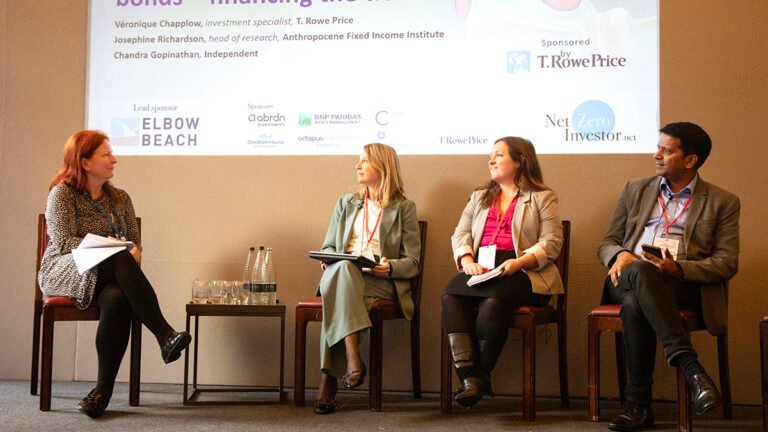With the green and sustainability-linked bond market expanding, investors are increasingly assessing the potential of their fixed-income holdings to drive climate impact. But which bond structure best supports net zero ambitions?
The combined issuance of green, social, and sustainability-linked bonds has now exceeded $5trn, according to the Climate Bonds Initative. Yet, the lack of an internationally recognised standard has sparked criticism, with some arguing that these bonds have become vehicles for greenwashing. The European Securities and Markets Authority (ESMA) is set to address this with new guidance on sustainability-related terminology in fund names.
The new rules, which will come into effect in December 2024, will require fund managers to align their portfolios with either the Paris-Aligned or Climate Transition Benchmarks. This change could prompt a significant overhaul of funds branded as “sustainable.”
Speaking at Net Zero Investor’s Annual Conference, Véronique Chapplow, an investment specialist at T. Rowe Price—a major provider of green bonds—acknowledged the increasing scrutiny of labelled bonds.
“I think companies that issue these types of instruments really realise they need to put in the work to ensure credibility… there’s auditing, reporting, and expertise required, and that’s beneficial for the industry. We’ve designed our proprietary ESG-level bonds to rigorously screen the yield process, reporting, and validity after issuance. Due diligence is still necessary, but the market is more mature than it was a few years ago,” she emphasised.
Enter SLBs
But some argue that labelled debt may not be the most impactful vehicle for addressing climate change. For example, the Anthropocene Fixed Income Institute (AFII) has been a strong proponent of sustainability-linked bonds (SLBs) and recently published an extensive guide on their benefits.
At the conference, Josephine Richardson, former credit trader at JP Morgan Chase and now head of research at AFII, explained her perspective on SLBs:
“Use-of-proceeds bonds like green bonds say, ‘I’ll take your money and spend it on specific, eligible projects,’ giving a layer of investor comfort. In contrast, sustainability-linked bonds don’t restrict spending to certain projects but instead commit to specific KPIs; if they’re missed or met, it adjusts bond terms, usually through a coupon adjustment. This structure offers greater accountability, though not necessarily a direct tie to asset use.”
Richardson stressed the enhanced accountability mechanisms that SLBs offer: “Green bonds have been effective from a PR standpoint, especially for portfolios needing regulatory compliance and transparency. But they’re still just bonds; investors can’t claim ownership over those ‘green assets’ if the issuer defaults. On the other hand, sustainability-linked bonds can provide tangible accountability through KPIs—if the issuer fails to meet targets, it impacts their capital costs. This accountability could be impactful in terms of supporting behaviour change.”
The role of green bonds
In contrast, Chandra Gopinathan, chair of the bondholder stewardship group at the Institutional Investor Group on Climate Change, argued that green bonds remain valuable in decarbonisation strategies, particularly for high-emitting sectors.
“In high-emitting sectors, green bonds are crucial as they allocate capital directly towards green commitments,” he stated, adding that investors should consider the issuer’s overall climate stance rather than viewing the green bond in isolation. “We need to consider the full financing strategy, not just a single product or bond. This holistic view is even more vital as corporates are now moving towards mandated transition planning, so alignment with broader financing strategies becomes key to meaningful transition,” he emphasised.
Transparency is central to achieving this, Gopinathan argued:
“When we discuss accountability mechanisms, it’s not just about disclosure but enabling investors to make informed decisions on what the issuer is achieving. The quality of the issuer’s commitment, alignment, and transparency are crucial in evaluating both green and sustainability-linked bonds.”
Chapplow highlighted that a broader approach could also be impactful:
“One of our impact strategies, our global impact credits, actually has about 40% of its allocation in non-labelled bonds. We don’t restrict ourselves to just green or labelled bonds but seek companies that actively contribute to big problems we’re addressing. Greenwashing is a significant risk, so rigorous scrutiny of these bonds, and especially issuer credibility, is essential.”
Powerful levers
With the debate heating up, panellists shared examples of how investors could apply pressure on issuers across different structures. Richardson cited the example of London & Quadrant Housing Trust, which recently missed an emissions reduction target for its SLB, incurring a $400 million penalty—a result she argued was positive for investors.
“Investors want accountability in bonds tied to performance metrics, not just compliance labels. While green bonds provide brand recognition and regulatory ease, sustainability-linked bonds hold issuers accountable through performance metrics. That’s appealing for investors who want the company to bear responsibility if targets are missed.”
Gopinathan added that accountability mechanisms could also be integrated into labelled debt:
“Investors should avoid over-reliance on labels and ensure they understand the issuer holistically. The Avengoa case is a prime example: the green label misled investors who overlooked fundamental governance issues. Sustainability labels alone are insufficient without thorough vetting of the issuer.”
The bigger picture
Ultimately, the panellists agreed that a comprehensive view of an issuer’s transition strategy and greater transparency are essential to address greenwashing in fixed income. Gopinathan concluded:
“Investors are often taking risks in these evolving bond structures, even without perfect information. It’s crucial to assess both labelled and non-labelled bonds based on the issuer’s transition commitment, as sometimes non-labelled bonds offer better risk-adjusted returns with strong issuer commitment.”
“We should not get overly focused on format or label alone. It’s vital to evaluate each issuer, their financing strategy, and their holistic impact. Labelled bonds are helpful, but they can’t replace deep issuer-level analysis,” he added.

